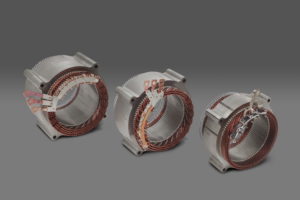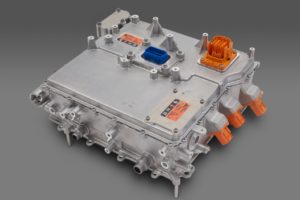
GM reveals the electric muscle behind its all-EV future
By onAnnouncements | Technology
General Motors this week unveiled a family of three all-new electric drive motors that can be used to propel a wide variety of vehicles as the automaker continues its pivot toward its eventual goal of 100 percent EV production.
The motors — a 180-kilowatt front-drive, a 255-kW rear- and front-drive and 62-kW all-wheel drive assist — were designed by GM as part of a platform the automaker calls Ultium Drive. GM says the motors were built as a scalable family, and will use similar tooling and manufacturing processes.
GM’s new EV technology, and insights into what it means for repairers, will be on the agenda for the OEM Collision Repair Technology Summit to be presented by the Society of Collision Repair Specialists during the SEMA Show. Global Aftersales Mechanical Engineering director Jennifer Goforth will once again be among the GM experts participating as panelists in that summit, scheduled for Nov. 4 at 9 a.m. Pacific time.
“Twenty years of electric drive system development and more than 100 years of high-volume vehicle engineering are helping GM pivot quickly from conventional vehicles to EVs,” GM President Mark Reuss said in unveiling the new motors at the 2021 Mackinac Policy Conference in Michigan.
“Our vertical integration in this space, encompassing both hardware and software, helps give us control over our own destiny and a significant competitive advantage.”
GM last year announced its intention to offer 30 battery electric vehicle models by 2025 in all four of its main brands. In January, the automaker promised to to make 40 percent of its models fully battery electric by 2025, and said it intends “to eliminate tailpipe emissions from new light-duty vehicles by 2035.” The plan was to go fully battery-electric with perhaps some hydrogen fuel cell offerings in the mix.
The two larger electric motors unveiled this week, GM said, are permanent magnet motors designed to minimize reliance on heavy rare earth materials, making them more suitable for volume production. Heavy rare earths used in magnet manufacturing, such as dysprosium and terbium, are unevenly distributed around the world, causing issues of supply and cost. The 62-kW assist unit is a conventional induction motor.
GM says that as many as three electric motors may be used in one EV. The first application of the new motors will be with the 2022 GMC Hummer EV that is to debut later this year, some versions of which will feature three separate 255-kW motors, yielding a GM-estimated output of 1,000 horsepower.

The power electronics of GM’s Ultium-based EVs will be integrated directly into the Ultium Drive units, reducing costs, weight and manufacturing complexity while increasing reliability. The inverter and other power electronics like the accessory power module and onboard charging module will reside within boxes such as this inside GM’s Ultium Drive units.
A related move toward high-volume EV production is GM’s development of software for Ultium Drive’s motor controllers, a critical part of meeting the needs of a variety of vehicle types with a minimal set of components. Artificial intelligence and machine learning were used in the development of the software, GM said.
“The software behind GM’s EV motors can be reused in many applications, providing fast go-to-market times as well as the foundation for future EV expansion as these motors are versatile enough to provide the power needs for a complete lineup of vehicles,” GM said.
It also said it has nearly 11,000 employees working on software development.
Other electrical components — such as the power module, or inverter that converts DC voltage from the battery to AC voltage to power the motor or motors — have also required new software.
The inverter and other power electronics, like the accessory power module and onboard charging module, are mounted outside of the drive units on GM’s current EVs. In Ultium-based vehicles, the automaker said, they will be integrated directly into the Ultium Drive units, cutting cost and simplifying manufacturing.
During the SEMA Show, Goforth will be among the participants in an SCRS OEM summit on electric vehicles, scheduled for 9 a.m. Las Vegas time on Thursday, Nov. 4. It is the first of three sessions in the OEM summit.
“The Summit’s three sessions feature distinctly different topics that host discussion between companies and individuals with rich histories of producing sophisticated advancements in the automotive and collision repair fields,” an online description reads.
“The event content will highlight developments in modern vehicles, with a focus on emerging trends that influence vehicle repairability and collision industry preparation.
“Every participant in this industry can benefit from better insight into how vehicles and materials are evolving, what that means in the repair process and what will be expected of those who are performing these repairs.
“The future of our collision repair industry is highly skilled professionals, working on highly sophisticated automobiles that require the industry to embrace the necessary investments in training and equipment; but also relies on informed business owners who understand how to define for themselves what a sustainable and successful business model to support that investment looks like.”
During last year’s virtual summit, GM executives reassured auto body shops that the manufacturer is taking the needs of the collision repair industry into account as it pursues electrification of its product lines.
Goforth then told the OEM Summit audience to expect electric vehicles to be “more mainstream” and to expect electric crossovers, SUVs and trucks.
“These are all very high-volume vehicles,” she said.
More information:
SCRS OEM Summit at the 2021 SEMA Show:
GM Reveals All-New EV Motors to Power an All-Electric Future
https://media.gm.com/media/us/en/gm/home.detail.html/content/Pages/news/us/en/2021/sep/0921-ultium-drive.html
Images:
Lead image: The motors that will power GM’s Ultium-based EVs were built as a scalable family, sharing design principles as well as similar tooling and manufacturing strategies. Pictured are the stators of all three motors.
The inverter and other power electronics like the accessory power module and onboard charging module will reside within boxes such as this inside GM’s Ultium Drive units. (GM)

